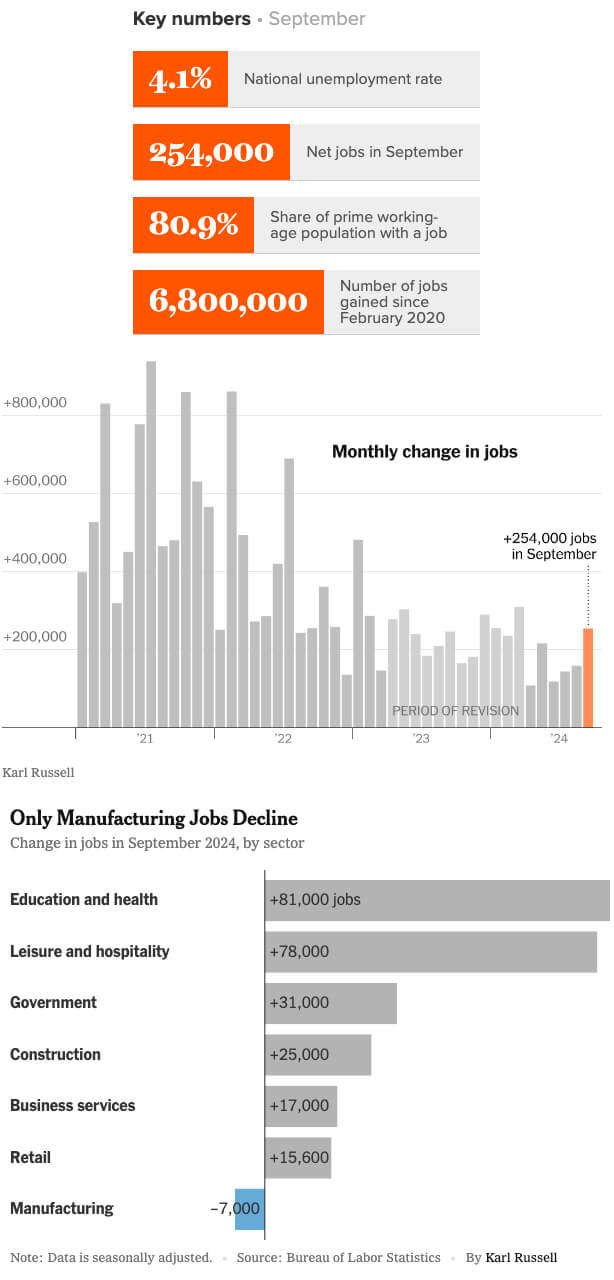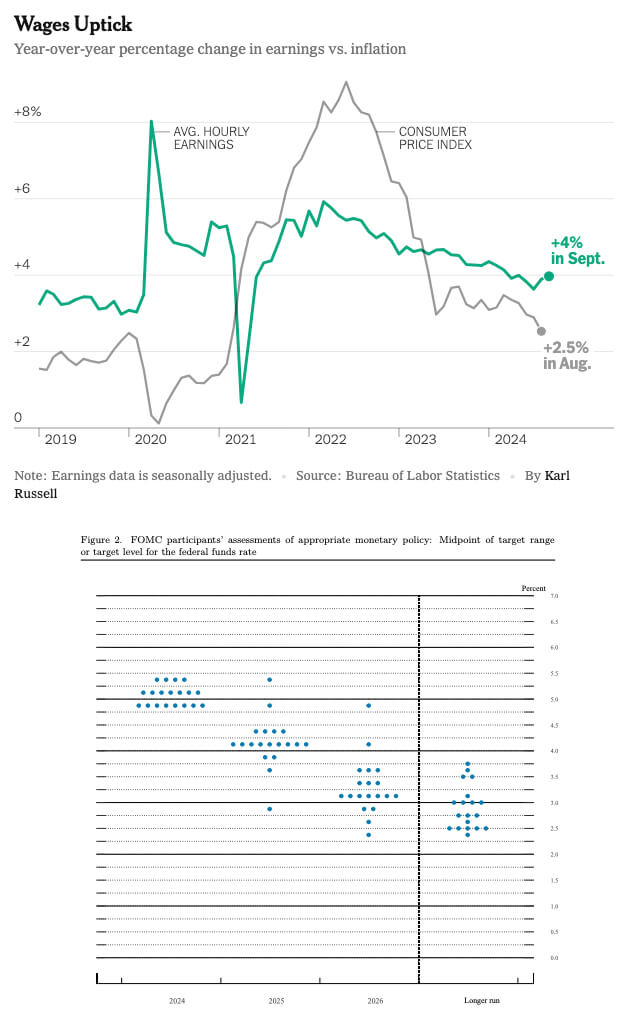Economic Update: October 2024
Change State Friends
Happy National Pumpkin Month and a spooktacular Halloween to all those who celebrate! 🎃 One fun fact about a rather polarizing seasonal item: did you know candy corn used to be called “chicken feed”, and was originally available year-round? 🐔 Check the link for more interesting tidbits on the world’s most divisive candy. Or, if you’re a candy enthusiast, maybe don’t – once you do, you can’t unlearn the secret ingredient responsible for candy’s shiny glaze. ☠️
As for the economy, last Friday’s report was a real thriller – let’s get into it.
Cheers, 👋
Nicole

Economic Snapshot
September’s jobs report arrived with a bang: payrolls shot up by 245,000 (the most in six months), and July and August numbers were revised upwards by 72,000. This took markets by surprise – economists polled by Reuters forecasted closer to 140,000, with estimates ranging from 70,000 to 220,000. Meanwhile the unemployment rate declined to 4.1% from 4.2% and prime-age EPOP held steady at a 23-year high. It would seem the US labor market has no intention of slowing down, after all.
Hiring was more broad in September as the number of industries increasing payrolls jumped from 51.8% to 57.6%. Hiring at restaurants and bars led the way, followed by adding 69,000 jobs, followed by healthcare adding 45,000. The household survey from which the unemployment rate is derived held other positive news: the drop in unemployment from August reflected an increase of 430,000 jobs in household employment, which more than absorbed the 150,000 people who entered the labor force. “It’s extremely hard to find any bad news in the report,” noted Guy Berger, Director of Economic Research at the Burning Glass Institute. He adds that: “We can think of the labor market as a “race” between a cooling trend and the Fed easing that is designed to stop it. Today’s data indicates that the Fed has more breathing space to win the race.”
For the last few months, the economy has been propped up by solid consumer spending and overall growth, but the job market has appeared more tepid. Policymakers forecasted that the job market would continue to slow slightly alongside increasing unemployment, but it appears the job market might be stabilizing already. People in their prime working years of 25 to 54 are employed at a rate previously seen only in the early 2000s, and women in particular are participating in the labor market at the highest levels on record. Workers’ wage gains were also better than expected, coming in at 4% over the last year, an uptick from August. Inflation has steadily fallen and now sits at 2.2%, only slightly above the official target, bucking the theory that pay gains would have to fall in order for inflation to cool. “With strong productivity, you can have strong wage growth […] I think that is a lot of what people missed, and are still missing,” said Sonu Varghese, macroeconomic strategist at Carson Group.
“Maybe underestimating the U.S. economy is a bad plan,” quipped Michael Madowitz, principal economist at the Roosevelt Institute. Indeed, Goldman Sachs has been cautiously optimistic about growth, even as it closely watches the labor market for signs of weakness.

Mainstream opinion would suggest that cooling inflation would come at the cost of a downturn in the labor market, but that hasn’t been the case so far. Falling inflation and continued sustained growth in hiring would be a huge win for the Fed: “Perhaps we should reassess our analytical framework of soft landing versus hard landing and just call it what it is: a robust economic expansion,” declared RSM U.S. chief economist Joe Brusuelas.
Fed policymakers lowered interest rates by half a point in September, an unusually large rate cut and their first in more than four years. However, good news for the Fed may mean bad news for those looking for a faster pace of interest rate cuts. Investors now expect a quarter-point rate cut in November, where they had previously been split between expecting a half or a quarter-point reduction. “Given where the economy is today, I view the costs of easing too much too soon as greater than the costs of easing too little too late,” noted Bank of St. Louis President Alberto Musalem.
Several experts also suggest that the Fed may have chosen not to make such a large rate move if they’d had any indication of what the September jobs report had in store:
- “With the benefit of hindsight, the 50-basis-point cut in September was a mistake, though not one of great consequence,” stated Former Treasury Secretary Lawrence Summers.
- If the Fed had known the revisions to the July and August prints in advance, it is very likely that they would have gone for a 25 basis points move instead,” concurred Kyle Chapman, analyst at Ballinger Group.
Chicago Fed President Austan Goolsbee welcomed the report but cautioned, “If you look at expectations, there are some signs that inflation might undershoot the 2% target, and we want to be mindful of that too.” Fed Chair Powell agreed in a statement last week: “Our design overall is to achieve disinflation down to 2% without the kind of painful increase in unemployment that has often come with disinflation processes […] we haven’t completed that task.” We’ll know a little more tomorrow when the September CPI data will be released. While this will be the last CPI report before the next Fed meeting in early November, we will see one more employment report to mine for clues before then.
“I actually think we are in the mother of all soft landings,”
–Diane Swonk, chief economist at KPMG
(Sources: Economic Policy Institute, Reuters, Bloomberg The Washington Post, Guy Berger via Substack, FederalReserve.gov, Federal Reserve Bank of St. Louis, U.S. Bureau of Labor Statistics, The New York Times, The Wall Street Journal, Forbes)
What else?

What Else for October?
- X (née Twitter) commentary on the September jobs report from the EPI here and here.
- New research from Lightcast, The Rising Storm, is a follow-up to their outstanding 2021 report The Demographic Drought. A must-read for anyone who will be affected by the looming labor shortage – which is, well, everyone. This latest version offers updated insights into the labor force dynamics that will transform our lives in the coming years, as well as actionable strategies businesses, educators, and government leaders should implement now.
- It’s the 10th Anniversary edition of McKinsey’s Women in the Workplace Report, the largest study of women in corporate America. In 2024, some things have changed, but much sadly remains the same. Women have made gains, especially in senior leadership roles; however, this progress is at risk of stalling or declining, especially for women of color, who remain significantly underrepresented at the highest levels. The report also reveals a decline in corporate commitment to gender diversity, with only 78% of companies now considering it a high priority, down from 88% in 2017.
- From Gartner, How to Make Informed Choices When Deploying Generative AI in HR outlines five primary approaches to deploying GenAI in HR, along with key questions HR teams can ask technology providers to find the best fit.
- The recent Global Workplace Report from Workday Job highlights key trends currently shaping the workforce. One tidbit: applications grew at 4x the rate of job advertisements, a strong indicator that we are in an employer’s job market today.
- Research into global “Blue Zones” has captivated those looking for the cheat codes to health and longevity. However, new research shows that the claims are bogus for most of these locations.
Do you know someone who would like this newsletter? Share it with them!
(Sources: Economic Policy Institute, Lightcast, McKinsey, Gartner, Workday, The Daily Mail)
